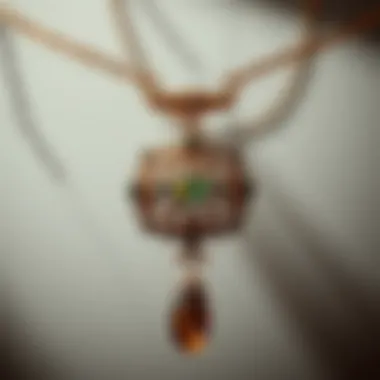Where to Sell Necklaces: A Comprehensive Guide


Intro
Selling necklaces, whether handmade or sourced from suppliers, offers not just a way to make money but also a chance to express creativity and connect with others. With the rise of the internet, the landscape of selling jewelry has changed dramatically. This guide aims to illuminate where and how to sell necklaces effectively in today’s marketplace. We’ll explore various avenues—both traditional brick-and-mortar shops and online platforms—analyzing their unique advantages and challenges.
This comprehensive guide will also touch on market trends and insights into target audiences that can help you tailor your selling strategy. From understanding consumer preferences to optimizing your listing for search engines, the information provided here is designed to enhance your selling experience and help you maximize your profits. Let's delve deeper into the world of selling necklaces and discover what it has to offer.
Understanding the Market for Necklaces
Selling necklaces can be a rewarding venture, but understanding the market is essential for success. Knowing the ins and outs of this niche not only helps in pinpointing the right selling strategies, but also equips sellers with insights about consumer behavior, preferences, and trends. This segment of the guide delves into the growing landscape that surrounds necklace sales. It highlights why being informed about the market is not just beneficial, but necessary for anyone looking to make their mark.
In today's fast-paced society, where personal expression is paramount, necklaces serve as more than mere adornments. They tell stories, represent significant moments, and often symbolize individuality. Therefore, understanding the current market dynamics might present sellers with opportunities that translate into profitable ventures.
Moreover, keeping an eye on shifting trends is vital. Whether it’s the resurgence of vintage designs or the increasing demand for sustainable jewelry, staying updated can give sellers a leg up on the competition. Tools like Google Trends or social media insights can offer valuable snapshots of what styles are making waves.
The market for necklaces is also influenced by seasonal fluctuations, economic conditions, and changes in consumer spending patterns. For example, during holiday seasons, it's common to see a spike in sales. Sellers should take these variables into account when planning their selling strategy to ensure they are maximizing their potential profit.
Identifying who your customer base is forms another crucial aspect. Every necklace tells a story, and so do the people who wear them. Recognizing the target audience allows sellers to tailor their offerings effectively. Is the buyer a fashionable millennial looking for statement pieces, or an older collector who appreciates craftsmanship? Answers to such questions lay the foundation for any selling strategy.
"To succeed in selling necklaces, one must not only know what to sell but also to whom and when."
A thorough grasp of market insights empowers sellers to position their products in a way that appeals directly to their intended audience. Many successful sellers often emphasize the importance of regular market research, helping them navigate the complexities of consumer desires and trends effectively.
In summary, understanding the market for necklaces isn't merely a preliminary step—it's an ongoing process that shapes your selling outcomes. By getting a handle on current trends and identifying the target audience, anyone can hone their approach for success.
Traditional Selling Venues
When it comes to selling necklaces, traditional venues often bring a classic charm and familiarity that can resonate well with both sellers and buyers. Utilizing these outlets can tap into an established customer base, making it easier to sell pieces without having to overly rely on digital methods. Moreover, local shops and markets often attract a clientele that prefers personal interactions over anonymity of online shopping. Sellers should also consider how traditional methods can offer immediate feedback and engagement with customers, which is invaluable for improving products and marketing strategies.
Local Jewelry Stores
Local jewelry stores represent one of the most respected and trusted venues for selling necklaces. These establishments frequently have a loyal following, built through years of providing quality pieces and personal service. When you bring your necklace to a local shop, you get the chance to showcase your work in a professional setting. Many store owners are keen on supporting local artisans, and this could be your entry point into a brick-and-mortar retail space.
For sellers, partnering with local jewelry stores can offer significant advantages:
- Expert Insights: Store owners are often willing to provide feedback on your designs and pricing strategies, benefiting your business.
- Marketing: Many shops engage in local marketing, which means your necklace could be featured in promotional campaigns, reaching potential customers who may not be aware of you yet.
- In-Store Promotions: Some stores run events where local artists can showcase their pieces, allowing you to gain direct exposure to a targeted audience.
However, it’s vital to understand that each shop will have different commission rates and terms of consignment. It’s wise to have a clear discussion about these factors upfront.
Pawn Shops
Pawn shops are often viewed as a last resort for selling jewelry, but they can be surprisingly effective depending on the situation. These establishments typically deal in a wide array of items, including fine jewelry. Selling to a pawn shop can yield quick cash, especially if time is of the essence.
Consider the pros and cons before heading to a pawn shop:
- Quick Transactions: If you need cash fast, pawn shops can provide instant payment for your necklace.
- Negotiation: Don’t be afraid to haggle on the price. Many pawn shop owners expect some level of negotiation.
However, it’s important to keep in mind:
- Lower Prices: You may not fetch a high price compared to other selling venues due to the shop's need to resell at a profit.
- Limited Exposure: Unlike local stores, pawn shops may not draw in customers specifically looking for unique handcrafted pieces.
Craft Fairs and Markets
Craft fairs and local markets are hands-on venues that allow you to personally engage with potential buyers. Setting up a booth at an event can be a rewarding experience, especially when you can connect face-to-face with customers who appreciate the artistry behind your necklace.


Benefits of these settings include:
- Direct Sales: You keep all profits without paying commissions to third parties.
- Customer Interaction: These venues allow you to explain the story behind your designs, which can create a deeper emotional connection with buyers.
While craft fairs can be fruitful, these considerations matter:
- Fees: Be prepared to pay for booth space, which can cut into your profits.
- Weather Dependent: Outdoor markets are susceptible to the whims of Mother Nature, which can impact attendance.
Consignment Shops
Consignment shops offer a middle ground between traditional and creative selling venues. They allow sellers to display their necklaces while providing the shop a cut of the profits upon sale. This arrangement can help craft makers access a broader audience without the overhead of running a retail space.
Key aspects to weigh in:
- Affordability: Economically, you might find it easier to work under this model as initial costs are lower.
- Visibility: Being in a busy consignment shop could open doors to customers who may not venture into a jewelry-specific store.
However, sellers need to be aware of things like:
- Shared Profits: Understand the shop's commission structure.
- Initial Evaluation: The shop's team may reject your pieces if they don’t fit their customer base, so selection criteria can be rigid.
In closing, traditional selling venues provide various pathways for sellers looking to market their necklaces. These options, ranging from local shops to consignment arrangements, each come with their own set of rewards and challenges, and understanding them thoroughly will help tailor your approach as you find the most suitable platforms to showcase your unique pieces.
Online Platforms for Selling Necklaces
In the constantly changing landscape of jewelry sales, online platforms have emerged as powerful tools for selling necklaces. These digital spaces offer a range of benefits, from expanded customer reach to lower overhead costs. Selling jewelry online can feel a bit like casting a wide net in a sea of potential buyers. Not only do these platforms facilitate sales, but they also speed up the interactions between sellers and buyers. In a world where convenience reigns supreme, understanding the nuances of these platforms can make all the difference.
E-commerce Websites
When it comes to selling necklaces, e-commerce websites are often the first stop for many prospective sellers. A site like Shopify or Etsy combines user-friendly interfaces with robust selling tools, allowing vendors to easily set up their shops. The customizability of such platforms means that sellers can create a unique brand identity. Furthermore, these platforms often provide extensive resources for marketing, analytics, and even payment processing, which can be immensely helpful for those just starting out.
Visit the following for more on e-commerce: Shopify and Etsy.
Social Media Marketplaces
Social media has revolutionized how we connect, and it has done the same for the jewelry market. Facebook and Instagram have become popular platforms for selling necklaces because they allow for interactive engagement with potential customers. Sellers can post visually appealing images of their necklaces, showcasing them in different contexts. Additionally, features such as Instagram Shopping or Facebook Marketplace make it easy to list products directly on these platforms. Regular interaction through posts and stories builds rapport with customers, encouraging brand loyalty, which is often more effective than traditional advertising.
"Social proof is a powerful motivator. Seeing friends interacting with a product can prompt immediate purchasing decisions."
Auction Websites
If you're looking to sell unique or vintage necklaces, consider using auction websites like eBay. Auction sites allow sellers to set starting prices and engage in bidding wars, which can sometimes lead to unexpected profits. This method benefits from a diverse audience, as collectors and enthusiasts flock to sites searching for one-of-a-kind items. However, it’s crucial to have a keen sense of market value, as setting too high of a price could deter bidders. Sellers should also keep in mind the fees associated with these platforms, which can eat into potential profits.
For more details, look into eBay.
Online Jewelry Marketplaces
Marketplaces like Brilliant Earth and Blue Nile specifically cater to jewelry, providing an ideal ecosystem for selling necklaces. Buyers visiting these sites often already have the intent to purchase, which minimizes the selling efforts on the part of the seller. These platforms also tend to offer various selling options, whether consignment or outright sale. However, one must also consider the commission fees involved with these platforms, which might be higher compared to general e-commerce sites.
These specialized marketplaces can ensure your necklaces are in front of a targeted audience of jewelry buyers.
As you navigate your options for selling necklaces online, it’s essential to consider your unique selling proposition, pricing strategy, and the demographic you aim to reach. By aligning the right platform with your products, you can significantly enhance your chances of making successful sales.
Marketing Strategies for Selling Necklaces
Understanding marketing strategies is essential for anyone wanting to sell necklaces effectively. In a saturated market filled with diverse styles, materials, and target demographics, having a clear plan can make all the difference. The right marketing efforts can not only elevate your brand but also help foster trustworthy connections with customers. From leveraging online platforms to building a meaningful narrative around your products, a robust marketing strategy can enhance visibility, boost sales, and cultivate customer loyalty.


Creating Engaging Product Listings
When it comes to selling necklaces, the first impression often occurs through your product listings. An engaging product listing is more than just a description; it’s an opportunity to tell a story that resonates with potential buyers. A well-crafted title includes all the key attributes of your necklace, such as material, style, and occasion it suits. For instance, instead of naming a product "Silver Necklace," consider something descriptive like "Handcrafted Sterling Silver Charm Necklace with Amethyst Stone."
In the body of your listing, incorporate high-quality images from various angles. Descriptions should detail the quality, craftsmanship, and unique features of your necklaces. Consider using bullet points for key features to allow easy scanning.
- Material: Specify metals or gemstones used.
- Size: Provide measurements to help buyers visualize it.
- Care Instructions: Mention how to maintain their investment.
"A picture may be worth a thousand words, but a captivating description will seal the deal."
Utilizing SEO Techniques
Search Engine Optimization (SEO) is fundamental in drawing organic traffic to your listings. SEO techniques help increase your visibility on various platforms, making it easier for potential customers to find your necklaces. Start by researching relevant keywords that your target audience is likely to use when searching for products like yours. For example, terms such as "handmade gemstone necklace" or "bohemian style jewelry" could be effective.
Once you have identified your keywords, integrate them into your product titles, descriptions, and even image alt texts. It's also useful to create engaging blog content about trends or care tips for necklaces, as this can enhance your website's SEO and position you as an industry expert.
Below are a few effective SEO strategies you can implement:
- Keyword Research: Identify keywords relevant to your niche.
- Quality Content: Write informative articles showcasing your knowledge.
- Backlinks: Gain links from trusted sources to increase authority.
Leveraging Social Media for Promotion
Social media has transformed the way businesses engage with their customers. Platforms like Instagram and Facebook allow sellers to promote their necklaces visually and directly interact with their audience. Start by setting up appealing profiles that reflect your brand identity and core values.
Creating a content calendar can help maintain a consistent posting schedule. Share high-quality images of your necklaces, alongside lifestyle shots that demonstrate how they can be worn. Utilizing hashtags can also attract a larger audience.
Consider hosting giveaways or partnering with influencers in the jewelry niche to reach an audience that might otherwise be uninterested. Engaging with your community through comments, messages, and stories can also build loyalty and trust, encouraging followers to become customers.
Legal Considerations When Selling Necklaces
When diving into the world of necklace selling, whether you’re a hobbyist or a professional jeweler, understanding legal considerations is paramount. These elements not only shape your selling strategy but also protect you and your customers. Knowledge of the law can prevent headaches down the road, ensuring a seamless experience for everyone involved.
The importance of knowing legal matters can't be overstated. A well-informed seller reduces the risk of encountering legal troubles that could sour the joy of sharing their creations. From rights to ownership, taxation issues, to understanding consumer protection laws, each factor plays a vital role. Consider this your blueprint, paving the way toward successful sales with minimal legal friction.
Understanding Local Laws
Each region has its own set of laws that govern the sale of jewelry, including necklaces. It’s essential to get familiar with these laws, as they can vary widely and have a direct impact on your selling practices. Some common areas to investigate include:
- Licensing Requirements: Many states or municipalities require permits or licenses for selling jewelry, especially if you're setting up shop online or at local fairs. Make sure you check with your local government to see what's required.
- Product Standards: Selling jewelry often means adhering to strict product safety and labeling laws. For instance, if you’re crafting necklaces with potentially harmful substances, you’re obligated to follow specific safety regulations.
- Consumer Protection Laws: These laws ensure that buyers are treated fairly. They govern aspects like returns, warranties, and advertising. Understanding these laws helps you maintain good relations with customers and avoid potential lawsuits.
Take a moment to visit USA.gov or similar resources to stay updated on local laws relevant to your selling practices.
Shipping Regulations and Insurance
Shipping necklaces brings about its own set of legal hoops to jump through. As you prepare to send your jewelry into the world, consider the following key aspects:
- Shipping Restrictions: Certain countries have specific laws regarding the importation of jewelry. Before sending your necklace internationally, familiarize yourself with restrictions and ensure compliance with any customs regulations. Always verify that your items can legally enter a given country.
- Insurance: Given that necklaces can have significant value—both sentimentally and financially—it’s wise to insure shipments. This means that should an item go astray, you can recoup the loss. Check with your shipping provider for options on insuring your parcels. Furthermore, if you offer delivery options, inform your customers about handling lost items or damages during transit.
- Customs Duties: Understanding duties and taxes applicable on shipped items can save a world of trouble. Some countries impose added fees for items crossing their borders, which can impact overall customer satisfaction.
In summary, arming yourself with knowledge about shipping regulations can streamline your selling processes. Proving that you've taken the time to ensure legal compliance not only demonstrates professionalism but also fosters trust with your clientele.
"Knowledge of the law is a critical tool for success in the jewelry business, ensuring that you can thrive without legal pitfalls."
By navigating these considerations effectively, your journey selling necklaces stands on a sturdy foundation, paving the way for both profit and peace of mind.


Challenges and Pitfalls in Selling Necklaces
Selling necklaces can look like a smooth sail, but it often comes with a bumpy ride. Understanding these challenges is crucial. Some of the main problems that sellers face include setting the right price, addressing customer concerns, and managing returns. This section aims to flesh out these challenges, providing insights that may help in carving a niche in this saturated market.
Pricing Strategies and Competitiveness
Determining the right price for necklaces is a dance between art and science. It's important to consider factors such as material costs, design intricacies, and market demand. As sellers, one must always keep an eye on competitors and market trends. An overly aggressive pricing strategy can lead to losses, while being too cautious might mean losing sales altogether. Moreover, sellers need to account for the perceived value versus actual costs. If you make handmade pieces, for instance, the time and effort put into the creation should be factored into the pricing.
"Pricing of jewelry is not just about covering costs; it's about telling a story."
When pricing is set, keeping an eye on competitor pricing is wise. Being competitive doesn’t mean undervaluing your work, though. Special promotions and seasonal discounts can entice customers, but don’t overdo it, or your brand’s value will take a hit. A steady hand during these times can maintain balance, ensure profitability, and retain the brand’s integrity.
Handling Returns and Customer Expectations
Dealing with returns is like walking a tightrope. Customers often have expectations shaped by previous shopping experiences, and any misalignment can lead to dissatisfaction. Establish a clear return policy that sets realistic guidelines. Explicit information about conditions for returns, what expenses customers may incur, and time limits for returning items must be communicated clearly.
Many sellers overlook the psychological aspect of returns. When customers are unhappy, they often feel compelled to share that experience, which could potentially tarnish your reputation. Building trust through excellent customer service can mitigate negative impacts.
An efficient returns process that respects customer needs can convert a potentially frustrating scenario into a positive experience. Following up with customers after a return can turn heads, demonstrating care for their satisfaction and nudging them to keep loyalty even after a return.
Enhancing Sales with Customer Engagement
In the highly competitive world of necklace sales, enhancing customer engagement is not just a luxury; it’s a necessity. Engaging customers effectively can lead to increased sales, greater brand loyalty, and an overall elevated shopping experience. In the jewelry market, where emotions often play a key role in purchasing decisions, it's particularly vital to create connections that go beyond mere transactions.
Building Customer Relationships
Establishing strong relationships with customers is paramount. People are more likely to buy from a brand they feel connected to, which is why personal touch matters. Here are some key elements to consider when fostering these relationships:
- Personalization: Tailor your communication and offerings to meet the individual preferences of your customers. Use data analytics to recommend necklaces based on past purchases or browsing history. This approach not only showcases that you understand their taste but also significantly enhances the shopping experience.
- Follow-Up Communication: After a sale, reach out to your customers. A simple thank-you email or note not only shows appreciation but also opens doors for future conversations. You can ask how they feel about their purchase and if they need any styling tips.
- Creating Community: Encourage customers to share their stories. Perhaps they wore your necklace to a particular event that meant a lot to them. Highlighting customer stories on your website or social media not only fosters loyalty but attracts new customers who may relate to these narratives.
Building genuine relationships requires time and effort, but the payoff is substantial. In a sector where product features can be similar, human connection becomes a significant differentiator.
Gathering and Utilizing Customer Feedback
Feedback can be a goldmine for improving your business, especially in the realm of necklaces which often have varied tastes and preferences. Listening to what your customers have to say can help in several ways:
- Identify Trends: Customer feedback can shine a light on emerging trends in necklace styles or materials. If multiple customers express interest in a certain type of necklace, consider boosting your inventory in that area.
- Enhance Product Quality: If you receive critiques about specific issues, whether it’s the clasp mechanism or the quality of stones used, addressing these concerns can significantly improve customer satisfaction and reduce returns. Customers tend to appreciate when their input leads to tangible changes.
- Directly Engage Customers: Use surveys and polls, perhaps through platforms like Facebook or via email, to directly ask your customers what they want or need. Customers feel valued when they are consulted and are more likely to support brands that seek their opinions.
"Gathering feedback and implementing changes based on that feedback is key to customer loyalty. When they see that you listen, they feel important and appreciated."
For further insights, you can reference articles on customer engagement strategies at Wikipedia or explore discussions on feedback mechanisms on reddit.com.
The End and Future Outlook
As we draw this extensive examination to a close, it's crucial to reflect on the varied avenues for selling necklaces and the dynamics shaping this arena. The landscape of jewelry sales is in constant flux, influenced by trends in consumer behavior, advancements in technology, and shifting economic factors. Grasping the essence of this subject holds immense value not just for current sellers but also for those considering entering the necklace marketplace. A well-rounded understanding equips sellers with the foresight needed to navigate challenges and seize emerging opportunities.
Reflections on Selling Necklaces
Selling necklaces isn't a mere transaction; it’s a dance between creativity and market sensibilities. Each piece carries a story, and understanding that narrative can forge connections with buyers. Sellers need to reflect on their unique designs, craftsmanship, and the emotions their jewelry evokes. Additionally, cultivating relationships through excellent customer service can lead to repeat business and word-of-mouth referrals.
Moreover, an awareness of market saturation can aid in positioning one's offerings effectively. When sellers reflect on their strategies, they may find that a distinct niche or a unique selling proposition is what will set them apart in a crowded marketplace.
Anticipating Future Trends
The future of necklace sales points toward a blend of tradition and modernity. Technology is already shaping how consumers shop, with augmented reality (AR) allowing potential buyers to virtually try on necklaces from the comfort of their homes. Sellers should prepare for an influx of data-driven insights that can help tailor their offerings to match consumer preferences.
Moreover, sustainability is likely to play an ever-greater role in purchasing decisions. Eco-friendly materials and ethical sourcing practices are becoming non-negotiable for many consumers today. Sellers tuned into these shifts can not only appeal to a broader audience but also contribute responsibly to the industry.
"The only constant in the marketplace is change itself; being adaptable is what sets successful sellers apart."
For further explore of the evolving nature of jewelry selling and to stay updated with the latest innovations, visit Wikipedia, or consider communities on Reddit for diverse perspectives.



